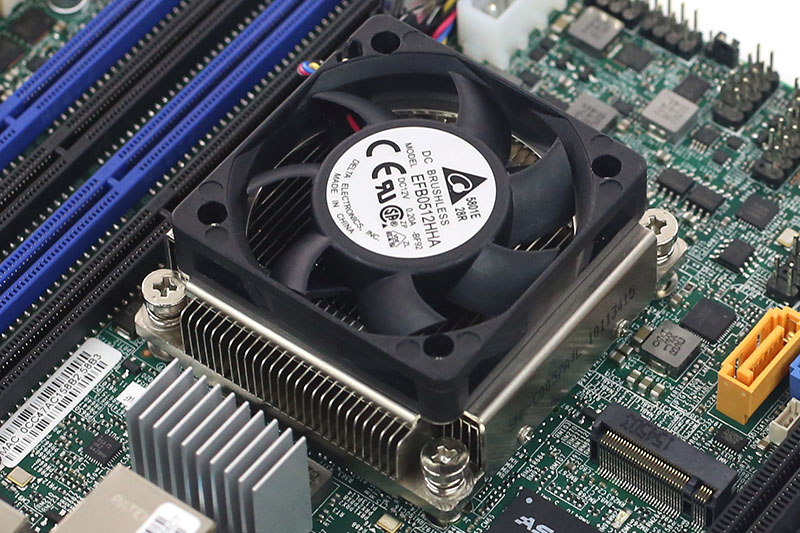Today we have Intel Xeon D-1528 benchmarks. Our most popular topic in 2015 was Intel Xeon D and in November 2015 we heard about the Intel Xeon D wave 2 launch. Continuing the tradition of having the first benchmarks of the Xeon D-1540 and Xeon D-1520 with the initial wave of Xeons. We had the first Xeon D-1518 benchmarks a few weeks ago for another 4 core/ 8 thread processor. The Intel Xeon D-1528 is a Xeon D-1500 wave 2 processor and the “8” in the model name lets us know that it is a networking optimized SKU. This is our first 6 core / 12 thread Xeon D that we have in our lab. It sports a low 35w TDP and has 9MB of L3 cache. Intel Xeon D parts currently have 1.5MB L3 cache per core and the cache scales with core count. To fit in the same 35w TDP of the Xeon D-1518 which is a 4 core / 8 thread 6MB L3 cache chip, the Intel Xeon D-1528 is clocked at 1.9GHz base with a 2.5GHz max turbo frequency.
For those interested, here is where the Xeon D-1528 falls in the currently announced Xeon D lineup:
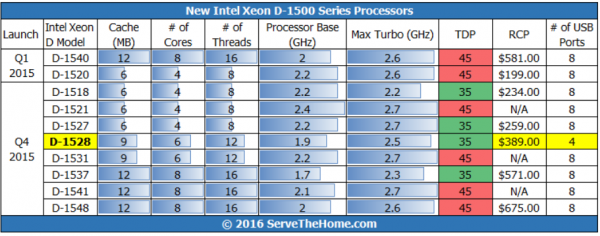
One can see that it is the only 6 core/ 12 thread model with a 35w TDP. We do know that 12 core and 16 core Xeon D parts are coming, but those have not officially been released yet. The 4USB port item we believe is a typo in the information that Intel gave us based on our experience with this platform and other Xeon D platforms.
Test Configuration
Our test platform is the Supermicro X10SDV-6C+-TLN4F. We will have a review of the motherboard shortly, complete with power and thermal imaging as we normally do.
- CPU: Intel Xeon D-1528 (embedded)
- Motherboard: Supermicro X10SDV-6C+-TLN4F
- Memory: 64GB – 4x Samsung 16GB DDR4 2133MHz ECC RDIMM
s
- SSD: 1x Intel DC S3700 400GB
- Operating System: Ubuntu 14.04.3 LTS, OpenSUSE 13.2
As another note, we tried picking some interesting comparisons out of our dataset. We decided against pitting this processor against dual E5-2699 V3 chips for obvious reasons. We did try to include some older results as often these chips will be replacing legacy hardware that can be several years old. We also had a single Westmere Xeon L5640 which was a “low power” 32nm generation part with a 60w TDP. Here is the ARK comparison of the Intel Xeon D-1528 and Xeon L5640. Can four generations newer architecture with lower cache and two DDR4 memory channels rather than 3 DDR3 make up for a ~300MHz clock speed delta? We will see soon enough.
Intel Xeon D-1528 Benchmarks
For our testing we are using Linux-Bench scripts which help us see cross platform “least common denominator” results. We are using gcc due to its ubiquity as a default compiler. One can see details of each benchmark here. We are likely going to update the Linux-Bench in the near future with a few new tests as well as an even simpler to use/ faster revision, but for now, we are using our old Ubuntu 14.04.3 version.
c-ray 1.1 Performance
We have been using c-ray for our performance testing for years now. It is a ray tracing benchmark that is extremely popular to show differences in processors under multi-threaded workloads.
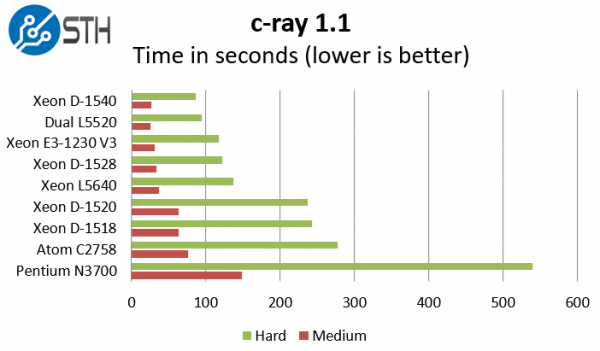
There is still a large amount of Nahalem-EP and Westmere-EP gear out there. As we saw with the Intel Xeon D-1540 last March, much of that gear might be replaced by the Xeon D platforms using less power. The Intel Xeon D-1528 certainly offers something much more competitive to a single six core, low power Westmere-EP offering, despite the slower clock speed.
7-zip Performance
7-zip is a widely used compression/ decompression program that works cross platform. We started using the program during our early days with Windows testing. It is now part of Linux-Bench.
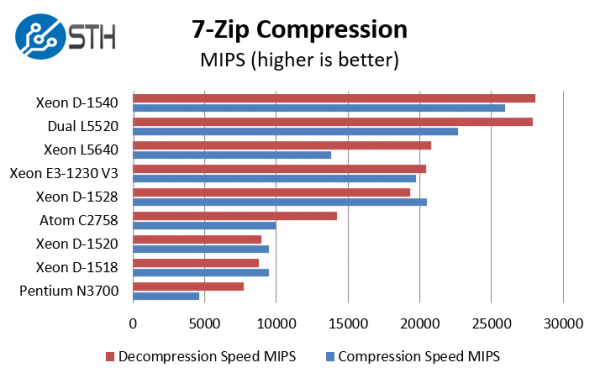
Compression is a major function in today’s workloads and we see the 6 core Xeon D-1528 perform very well here and right about where we would expect between its 4 and 8 core brethren.
NAMD Performance
NAMD is a molecular modeling benchmark developed by the Theoretical and Computational Biophysics Group in the Beckman Institute for Advanced Science and Technology at the University of Illinois at Urbana-Champaign. More information on the benchmark can be found here.
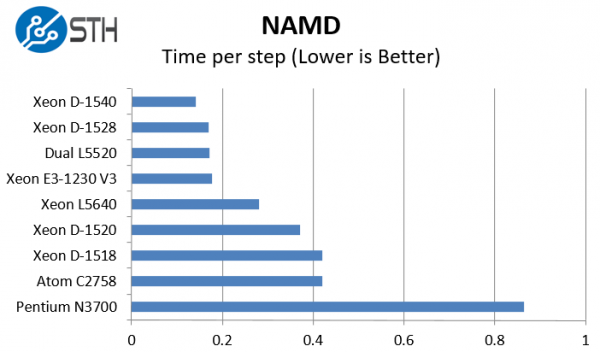
Again, as we might expect the D-1528 falls between other processors in the line. We do see architectural improvements bring a substantial lead over the older Westmere-EP single Xeon L5640 chip.
Sysbench CPU test
Sysbench is another one of those widely used Linux benchmarks. We specifically are using the CPU test, not the OLTP test that we use for some storage testing.
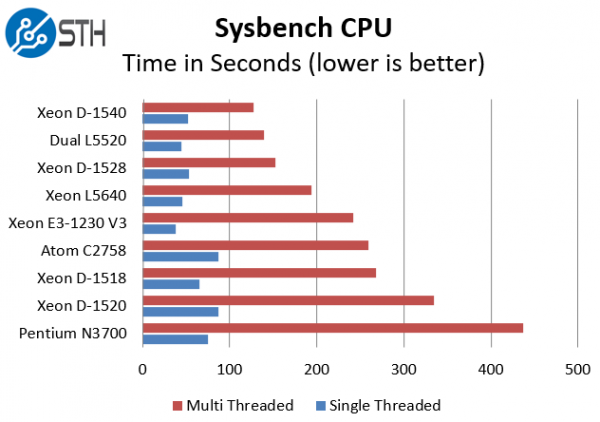
We sorted this chart on the multi-threaded results. Practically that means that the blue bars representing single threaded performance would change the ranking. What we can see is a fairly similar trend pushing the Xeon D-1528 directly into the general performance arena as the single Xeon L5640 and dual L5520 chips.
OpenSSL Performance
OpenSSL is widely used to secure communications between servers. This is an important protocol in many server stacks. We first look at our sign tests:
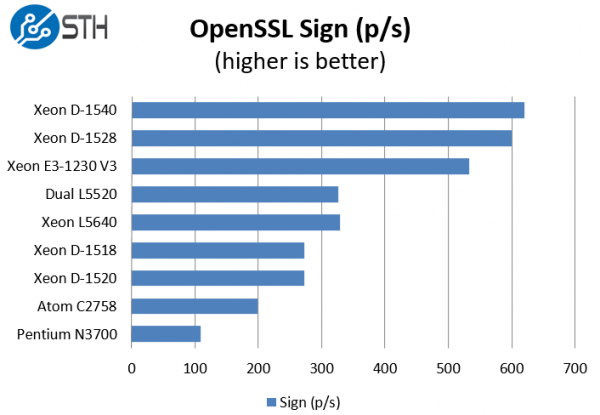
One can see here high-end speed of the Intel Xeon D-1528. Moving to the verify results:
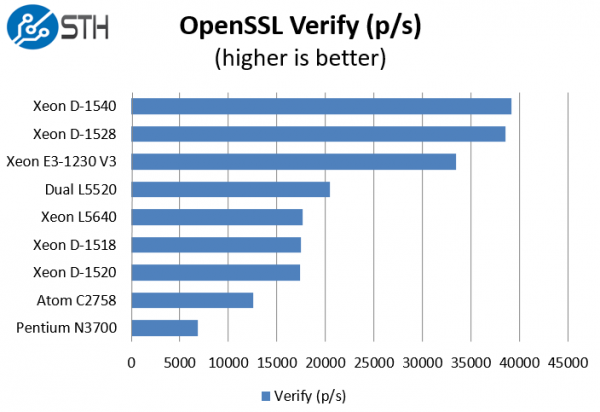
Frankly, we were a bit surprised about the results here as the Xeon D-1528 performed closer to the Xeon D-1540 than we would have expected. We did re-run the benchmarks on one of our D-1540 samples and found the results to be in-line with what we had in our database.
UnixBench Dhrystone 2 and Whetstone Benchmarks
Of course, these chips are not meant for heavy compute but we pick out the UnixBench 5.1.3 Dhrystone 2 and Whetstone results to show some of the raw performance they are capable of. UnixBench is widely used so it is a good comparison point.
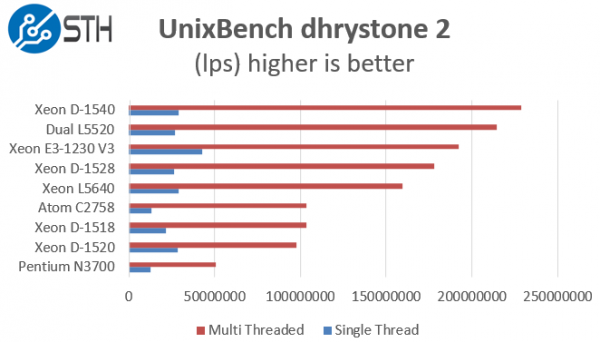
While we saw the D-1518 and D-1520 perform relatively similarly the D-1528 stands apart with its six cores and twelve threads.
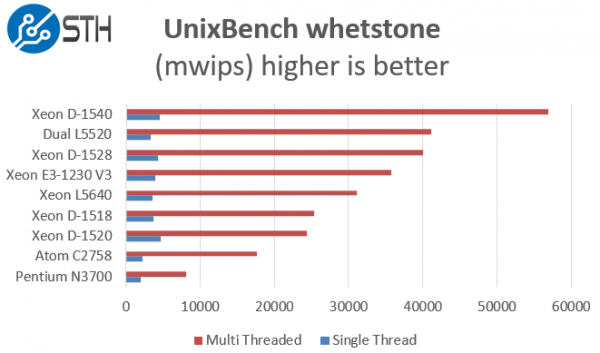
On the floating point side we see a similar trend. The new Xeon D-1528 bests the single Westmere-EP Xeon L5640 and is very close to the dual 4 core/ 8 thread Xeon L5520 system. It is doing so at a fraction of the power, less than half as we will show in the upcoming platform review.
HardInfo CPU Cryptohash
Perhaps some of the most standard benchmarks that come along with many versions of Ubuntu, the hardinfo suite has been a mainstay at STH.
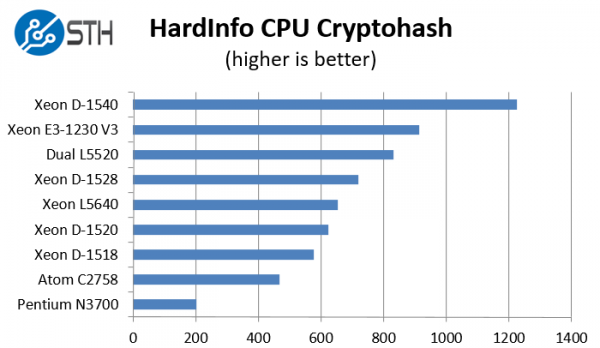
If you are looking for a step up from the Xeon D-1518 and want a lower cost option than the D-1540 or D-1541, the Xeon D-1528 is impressive.
Conclusion
If you are still clinging to a single Xeon L5640 or similar system, this Xeon D platform is going to make you think twice about how much power you are spending. We will have the review of the full Supermicro X10SDV-6C+-TLN4F platform soon but even with the dual 10GbE SFP+ NICs it is using less power than the TDP rating of the Xeon L5640 (60w). Released almost six years later we have a chip that runs faster at one third the price and less than half the power (at a system level). Looking back one more generation, the Xeon D-1528 is also now capable of keeping up with, and exceeding, the performance of dual Xeon L5520’s. Given the SoCs are soldered to the motherboards, having options for more cores and a price point between the D-1518/ D-1520 based platforms and the D-1540 is a welcome development.

